Competitive Strategy: SWOT Analysis, Ansoff Matrix, Porter Generic Strategies and Porter Five Forces
VerifiedAdded on 2023/06/10
|7
|1979
|171
AI Summary
This essay discusses four major strategic management tools including SWOT analysis, Ansoff matrix, Porter generic strategies and Porter five forces. Practical examples are discussed to have a clear understanding about the utility of these tools.
Contribute Materials
Your contribution can guide someone’s learning journey. Share your
documents today.
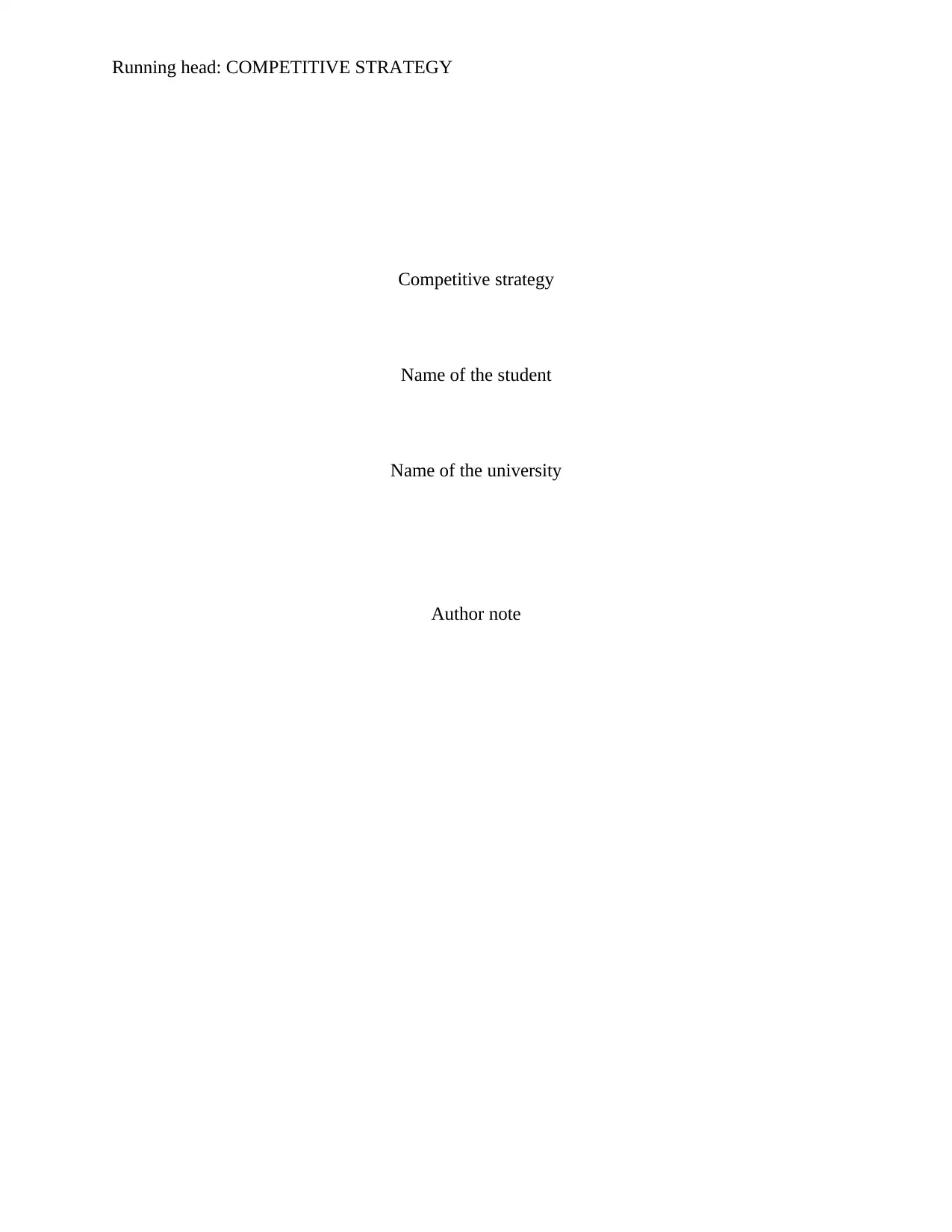
Running head: COMPETITIVE STRATEGY
Competitive strategy
Name of the student
Name of the university
Author note
Competitive strategy
Name of the student
Name of the university
Author note
Secure Best Marks with AI Grader
Need help grading? Try our AI Grader for instant feedback on your assignments.
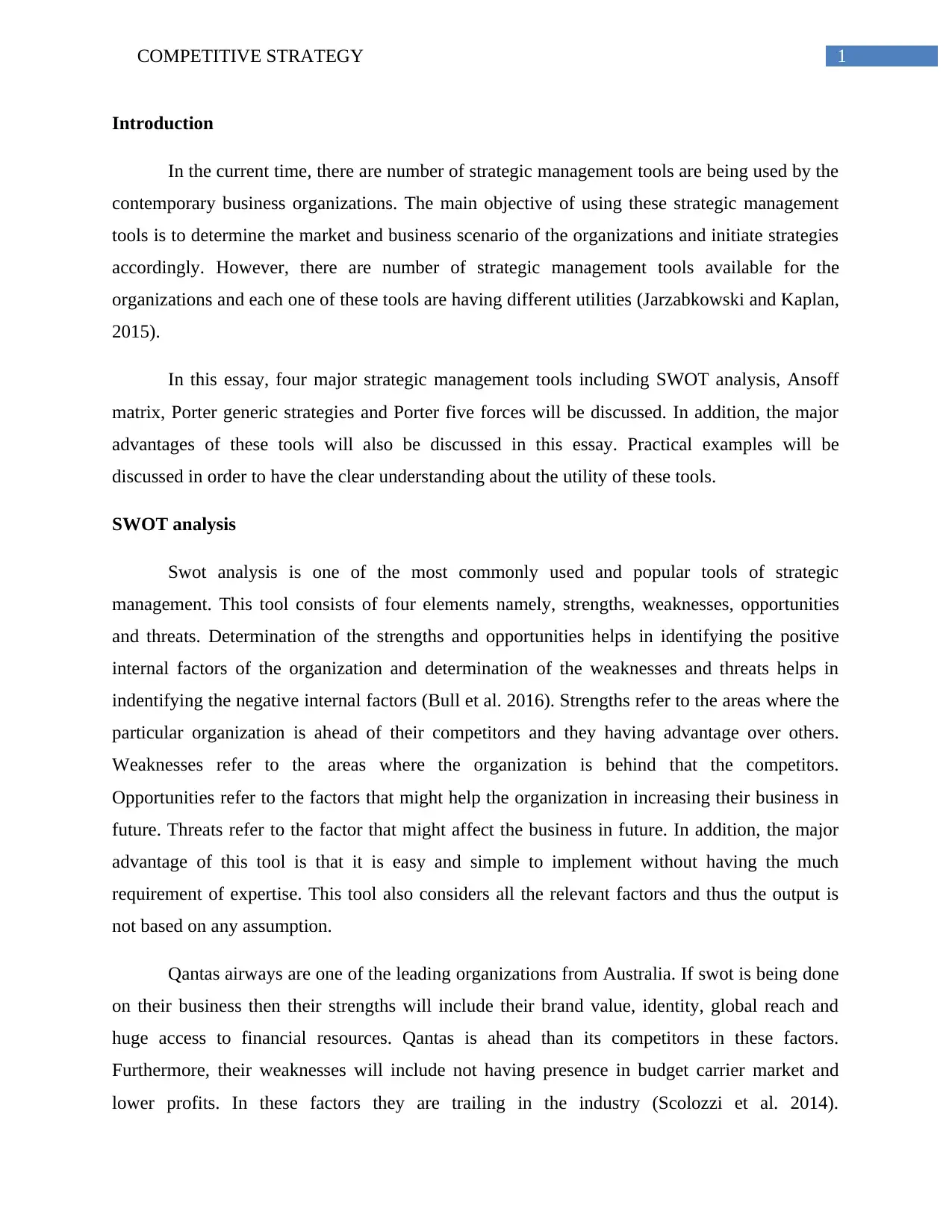
1COMPETITIVE STRATEGY
Introduction
In the current time, there are number of strategic management tools are being used by the
contemporary business organizations. The main objective of using these strategic management
tools is to determine the market and business scenario of the organizations and initiate strategies
accordingly. However, there are number of strategic management tools available for the
organizations and each one of these tools are having different utilities (Jarzabkowski and Kaplan,
2015).
In this essay, four major strategic management tools including SWOT analysis, Ansoff
matrix, Porter generic strategies and Porter five forces will be discussed. In addition, the major
advantages of these tools will also be discussed in this essay. Practical examples will be
discussed in order to have the clear understanding about the utility of these tools.
SWOT analysis
Swot analysis is one of the most commonly used and popular tools of strategic
management. This tool consists of four elements namely, strengths, weaknesses, opportunities
and threats. Determination of the strengths and opportunities helps in identifying the positive
internal factors of the organization and determination of the weaknesses and threats helps in
indentifying the negative internal factors (Bull et al. 2016). Strengths refer to the areas where the
particular organization is ahead of their competitors and they having advantage over others.
Weaknesses refer to the areas where the organization is behind that the competitors.
Opportunities refer to the factors that might help the organization in increasing their business in
future. Threats refer to the factor that might affect the business in future. In addition, the major
advantage of this tool is that it is easy and simple to implement without having the much
requirement of expertise. This tool also considers all the relevant factors and thus the output is
not based on any assumption.
Qantas airways are one of the leading organizations from Australia. If swot is being done
on their business then their strengths will include their brand value, identity, global reach and
huge access to financial resources. Qantas is ahead than its competitors in these factors.
Furthermore, their weaknesses will include not having presence in budget carrier market and
lower profits. In these factors they are trailing in the industry (Scolozzi et al. 2014).
Introduction
In the current time, there are number of strategic management tools are being used by the
contemporary business organizations. The main objective of using these strategic management
tools is to determine the market and business scenario of the organizations and initiate strategies
accordingly. However, there are number of strategic management tools available for the
organizations and each one of these tools are having different utilities (Jarzabkowski and Kaplan,
2015).
In this essay, four major strategic management tools including SWOT analysis, Ansoff
matrix, Porter generic strategies and Porter five forces will be discussed. In addition, the major
advantages of these tools will also be discussed in this essay. Practical examples will be
discussed in order to have the clear understanding about the utility of these tools.
SWOT analysis
Swot analysis is one of the most commonly used and popular tools of strategic
management. This tool consists of four elements namely, strengths, weaknesses, opportunities
and threats. Determination of the strengths and opportunities helps in identifying the positive
internal factors of the organization and determination of the weaknesses and threats helps in
indentifying the negative internal factors (Bull et al. 2016). Strengths refer to the areas where the
particular organization is ahead of their competitors and they having advantage over others.
Weaknesses refer to the areas where the organization is behind that the competitors.
Opportunities refer to the factors that might help the organization in increasing their business in
future. Threats refer to the factor that might affect the business in future. In addition, the major
advantage of this tool is that it is easy and simple to implement without having the much
requirement of expertise. This tool also considers all the relevant factors and thus the output is
not based on any assumption.
Qantas airways are one of the leading organizations from Australia. If swot is being done
on their business then their strengths will include their brand value, identity, global reach and
huge access to financial resources. Qantas is ahead than its competitors in these factors.
Furthermore, their weaknesses will include not having presence in budget carrier market and
lower profits. In these factors they are trailing in the industry (Scolozzi et al. 2014).
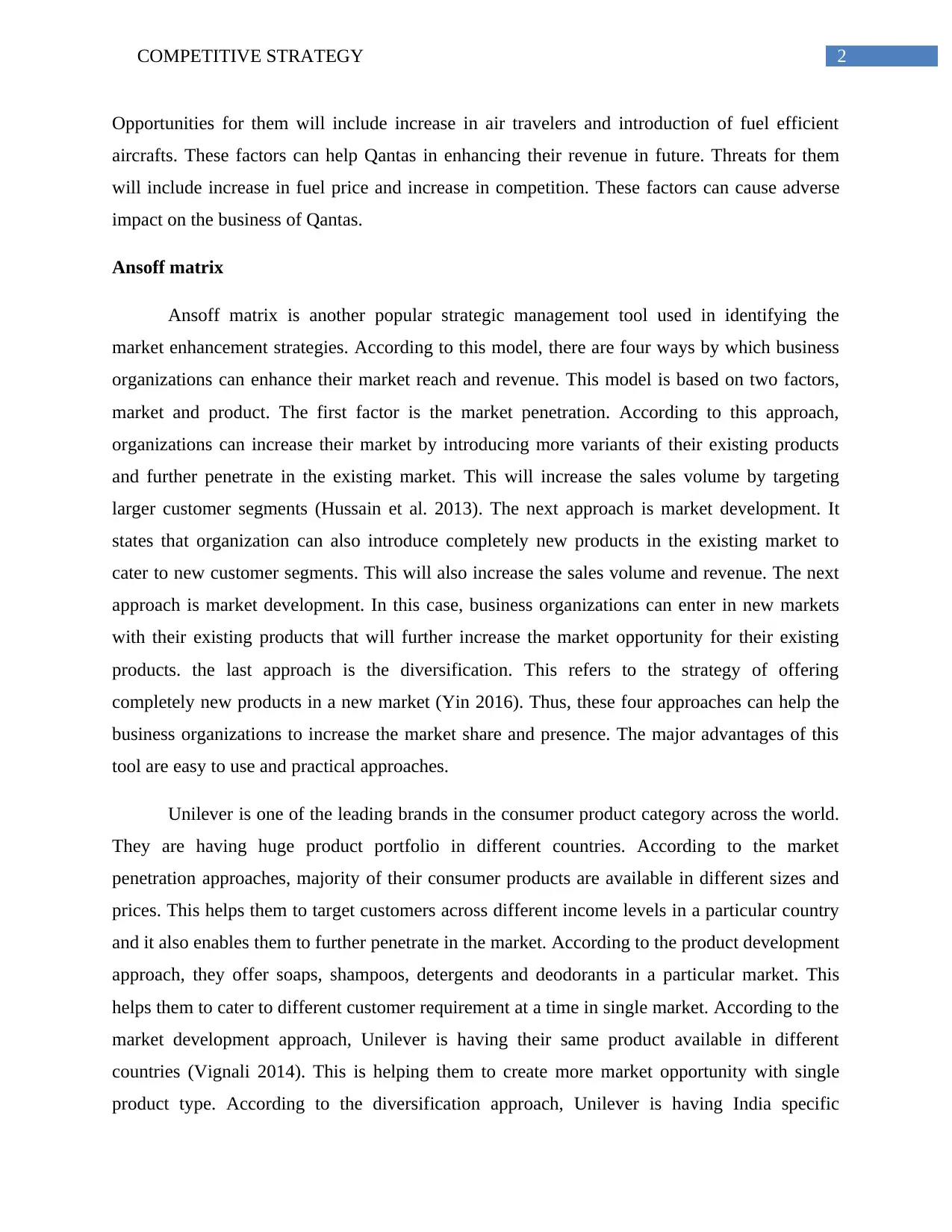
2COMPETITIVE STRATEGY
Opportunities for them will include increase in air travelers and introduction of fuel efficient
aircrafts. These factors can help Qantas in enhancing their revenue in future. Threats for them
will include increase in fuel price and increase in competition. These factors can cause adverse
impact on the business of Qantas.
Ansoff matrix
Ansoff matrix is another popular strategic management tool used in identifying the
market enhancement strategies. According to this model, there are four ways by which business
organizations can enhance their market reach and revenue. This model is based on two factors,
market and product. The first factor is the market penetration. According to this approach,
organizations can increase their market by introducing more variants of their existing products
and further penetrate in the existing market. This will increase the sales volume by targeting
larger customer segments (Hussain et al. 2013). The next approach is market development. It
states that organization can also introduce completely new products in the existing market to
cater to new customer segments. This will also increase the sales volume and revenue. The next
approach is market development. In this case, business organizations can enter in new markets
with their existing products that will further increase the market opportunity for their existing
products. the last approach is the diversification. This refers to the strategy of offering
completely new products in a new market (Yin 2016). Thus, these four approaches can help the
business organizations to increase the market share and presence. The major advantages of this
tool are easy to use and practical approaches.
Unilever is one of the leading brands in the consumer product category across the world.
They are having huge product portfolio in different countries. According to the market
penetration approaches, majority of their consumer products are available in different sizes and
prices. This helps them to target customers across different income levels in a particular country
and it also enables them to further penetrate in the market. According to the product development
approach, they offer soaps, shampoos, detergents and deodorants in a particular market. This
helps them to cater to different customer requirement at a time in single market. According to the
market development approach, Unilever is having their same product available in different
countries (Vignali 2014). This is helping them to create more market opportunity with single
product type. According to the diversification approach, Unilever is having India specific
Opportunities for them will include increase in air travelers and introduction of fuel efficient
aircrafts. These factors can help Qantas in enhancing their revenue in future. Threats for them
will include increase in fuel price and increase in competition. These factors can cause adverse
impact on the business of Qantas.
Ansoff matrix
Ansoff matrix is another popular strategic management tool used in identifying the
market enhancement strategies. According to this model, there are four ways by which business
organizations can enhance their market reach and revenue. This model is based on two factors,
market and product. The first factor is the market penetration. According to this approach,
organizations can increase their market by introducing more variants of their existing products
and further penetrate in the existing market. This will increase the sales volume by targeting
larger customer segments (Hussain et al. 2013). The next approach is market development. It
states that organization can also introduce completely new products in the existing market to
cater to new customer segments. This will also increase the sales volume and revenue. The next
approach is market development. In this case, business organizations can enter in new markets
with their existing products that will further increase the market opportunity for their existing
products. the last approach is the diversification. This refers to the strategy of offering
completely new products in a new market (Yin 2016). Thus, these four approaches can help the
business organizations to increase the market share and presence. The major advantages of this
tool are easy to use and practical approaches.
Unilever is one of the leading brands in the consumer product category across the world.
They are having huge product portfolio in different countries. According to the market
penetration approaches, majority of their consumer products are available in different sizes and
prices. This helps them to target customers across different income levels in a particular country
and it also enables them to further penetrate in the market. According to the product development
approach, they offer soaps, shampoos, detergents and deodorants in a particular market. This
helps them to cater to different customer requirement at a time in single market. According to the
market development approach, Unilever is having their same product available in different
countries (Vignali 2014). This is helping them to create more market opportunity with single
product type. According to the diversification approach, Unilever is having India specific
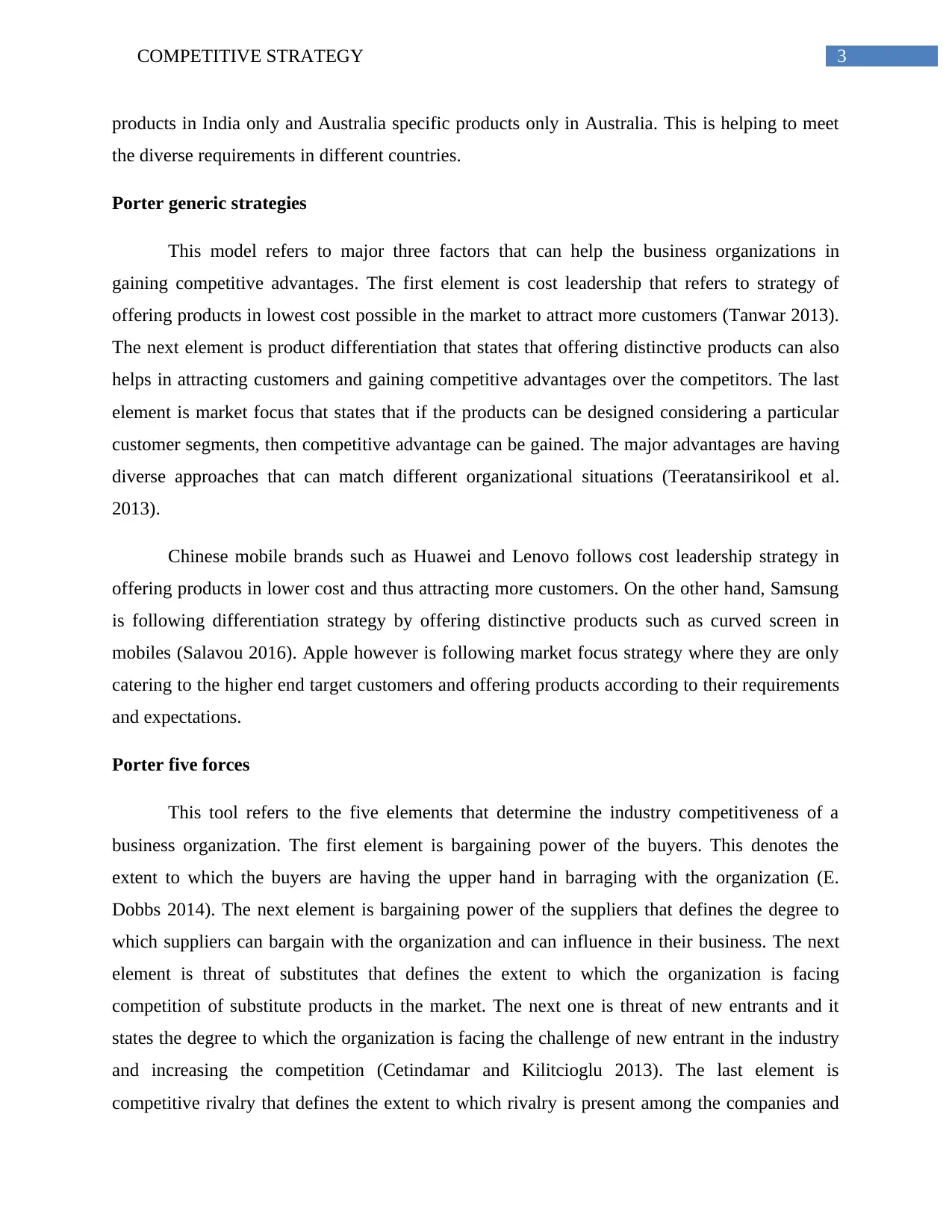
3COMPETITIVE STRATEGY
products in India only and Australia specific products only in Australia. This is helping to meet
the diverse requirements in different countries.
Porter generic strategies
This model refers to major three factors that can help the business organizations in
gaining competitive advantages. The first element is cost leadership that refers to strategy of
offering products in lowest cost possible in the market to attract more customers (Tanwar 2013).
The next element is product differentiation that states that offering distinctive products can also
helps in attracting customers and gaining competitive advantages over the competitors. The last
element is market focus that states that if the products can be designed considering a particular
customer segments, then competitive advantage can be gained. The major advantages are having
diverse approaches that can match different organizational situations (Teeratansirikool et al.
2013).
Chinese mobile brands such as Huawei and Lenovo follows cost leadership strategy in
offering products in lower cost and thus attracting more customers. On the other hand, Samsung
is following differentiation strategy by offering distinctive products such as curved screen in
mobiles (Salavou 2016). Apple however is following market focus strategy where they are only
catering to the higher end target customers and offering products according to their requirements
and expectations.
Porter five forces
This tool refers to the five elements that determine the industry competitiveness of a
business organization. The first element is bargaining power of the buyers. This denotes the
extent to which the buyers are having the upper hand in barraging with the organization (E.
Dobbs 2014). The next element is bargaining power of the suppliers that defines the degree to
which suppliers can bargain with the organization and can influence in their business. The next
element is threat of substitutes that defines the extent to which the organization is facing
competition of substitute products in the market. The next one is threat of new entrants and it
states the degree to which the organization is facing the challenge of new entrant in the industry
and increasing the competition (Cetindamar and Kilitcioglu 2013). The last element is
competitive rivalry that defines the extent to which rivalry is present among the companies and
products in India only and Australia specific products only in Australia. This is helping to meet
the diverse requirements in different countries.
Porter generic strategies
This model refers to major three factors that can help the business organizations in
gaining competitive advantages. The first element is cost leadership that refers to strategy of
offering products in lowest cost possible in the market to attract more customers (Tanwar 2013).
The next element is product differentiation that states that offering distinctive products can also
helps in attracting customers and gaining competitive advantages over the competitors. The last
element is market focus that states that if the products can be designed considering a particular
customer segments, then competitive advantage can be gained. The major advantages are having
diverse approaches that can match different organizational situations (Teeratansirikool et al.
2013).
Chinese mobile brands such as Huawei and Lenovo follows cost leadership strategy in
offering products in lower cost and thus attracting more customers. On the other hand, Samsung
is following differentiation strategy by offering distinctive products such as curved screen in
mobiles (Salavou 2016). Apple however is following market focus strategy where they are only
catering to the higher end target customers and offering products according to their requirements
and expectations.
Porter five forces
This tool refers to the five elements that determine the industry competitiveness of a
business organization. The first element is bargaining power of the buyers. This denotes the
extent to which the buyers are having the upper hand in barraging with the organization (E.
Dobbs 2014). The next element is bargaining power of the suppliers that defines the degree to
which suppliers can bargain with the organization and can influence in their business. The next
element is threat of substitutes that defines the extent to which the organization is facing
competition of substitute products in the market. The next one is threat of new entrants and it
states the degree to which the organization is facing the challenge of new entrant in the industry
and increasing the competition (Cetindamar and Kilitcioglu 2013). The last element is
competitive rivalry that defines the extent to which rivalry is present among the companies and
Secure Best Marks with AI Grader
Need help grading? Try our AI Grader for instant feedback on your assignments.
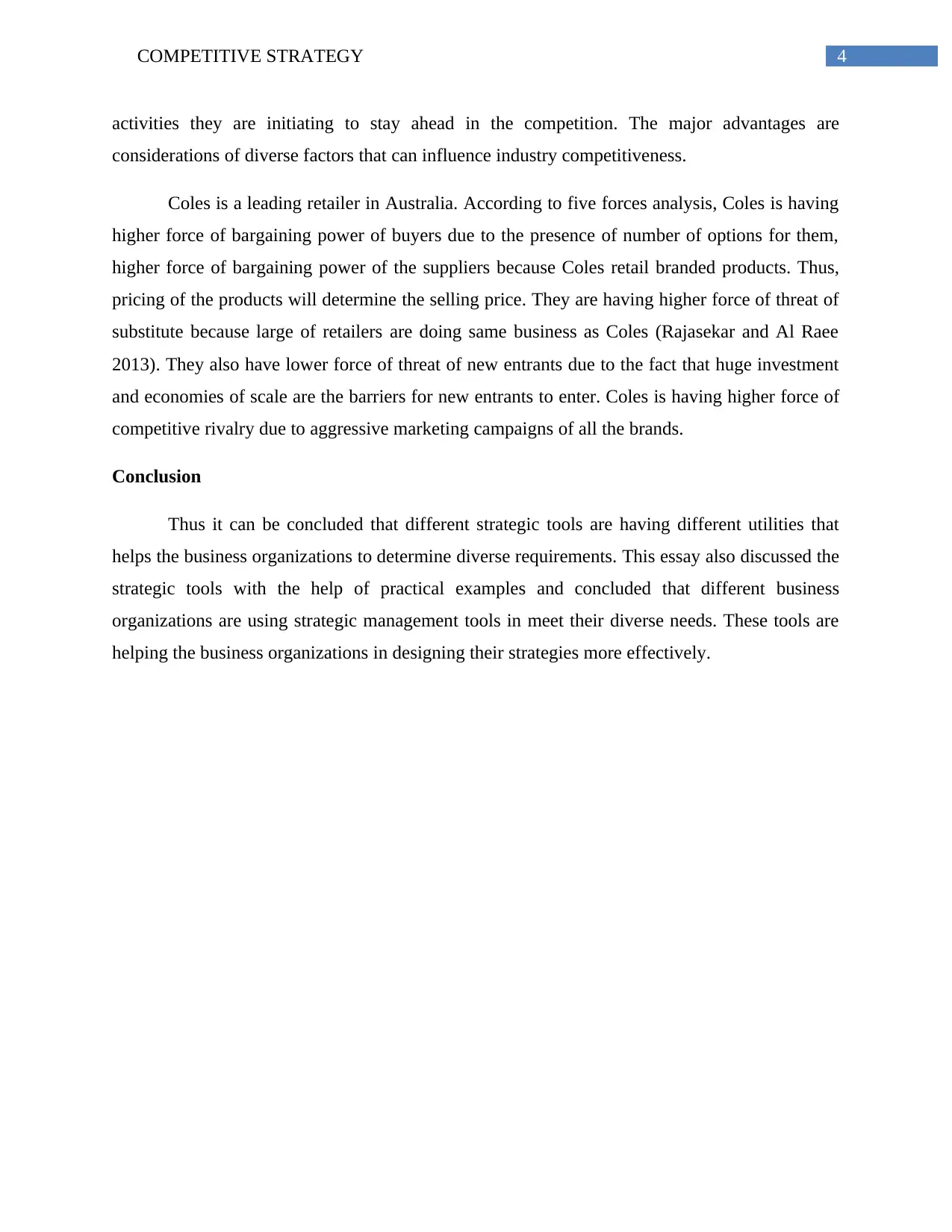
4COMPETITIVE STRATEGY
activities they are initiating to stay ahead in the competition. The major advantages are
considerations of diverse factors that can influence industry competitiveness.
Coles is a leading retailer in Australia. According to five forces analysis, Coles is having
higher force of bargaining power of buyers due to the presence of number of options for them,
higher force of bargaining power of the suppliers because Coles retail branded products. Thus,
pricing of the products will determine the selling price. They are having higher force of threat of
substitute because large of retailers are doing same business as Coles (Rajasekar and Al Raee
2013). They also have lower force of threat of new entrants due to the fact that huge investment
and economies of scale are the barriers for new entrants to enter. Coles is having higher force of
competitive rivalry due to aggressive marketing campaigns of all the brands.
Conclusion
Thus it can be concluded that different strategic tools are having different utilities that
helps the business organizations to determine diverse requirements. This essay also discussed the
strategic tools with the help of practical examples and concluded that different business
organizations are using strategic management tools in meet their diverse needs. These tools are
helping the business organizations in designing their strategies more effectively.
activities they are initiating to stay ahead in the competition. The major advantages are
considerations of diverse factors that can influence industry competitiveness.
Coles is a leading retailer in Australia. According to five forces analysis, Coles is having
higher force of bargaining power of buyers due to the presence of number of options for them,
higher force of bargaining power of the suppliers because Coles retail branded products. Thus,
pricing of the products will determine the selling price. They are having higher force of threat of
substitute because large of retailers are doing same business as Coles (Rajasekar and Al Raee
2013). They also have lower force of threat of new entrants due to the fact that huge investment
and economies of scale are the barriers for new entrants to enter. Coles is having higher force of
competitive rivalry due to aggressive marketing campaigns of all the brands.
Conclusion
Thus it can be concluded that different strategic tools are having different utilities that
helps the business organizations to determine diverse requirements. This essay also discussed the
strategic tools with the help of practical examples and concluded that different business
organizations are using strategic management tools in meet their diverse needs. These tools are
helping the business organizations in designing their strategies more effectively.
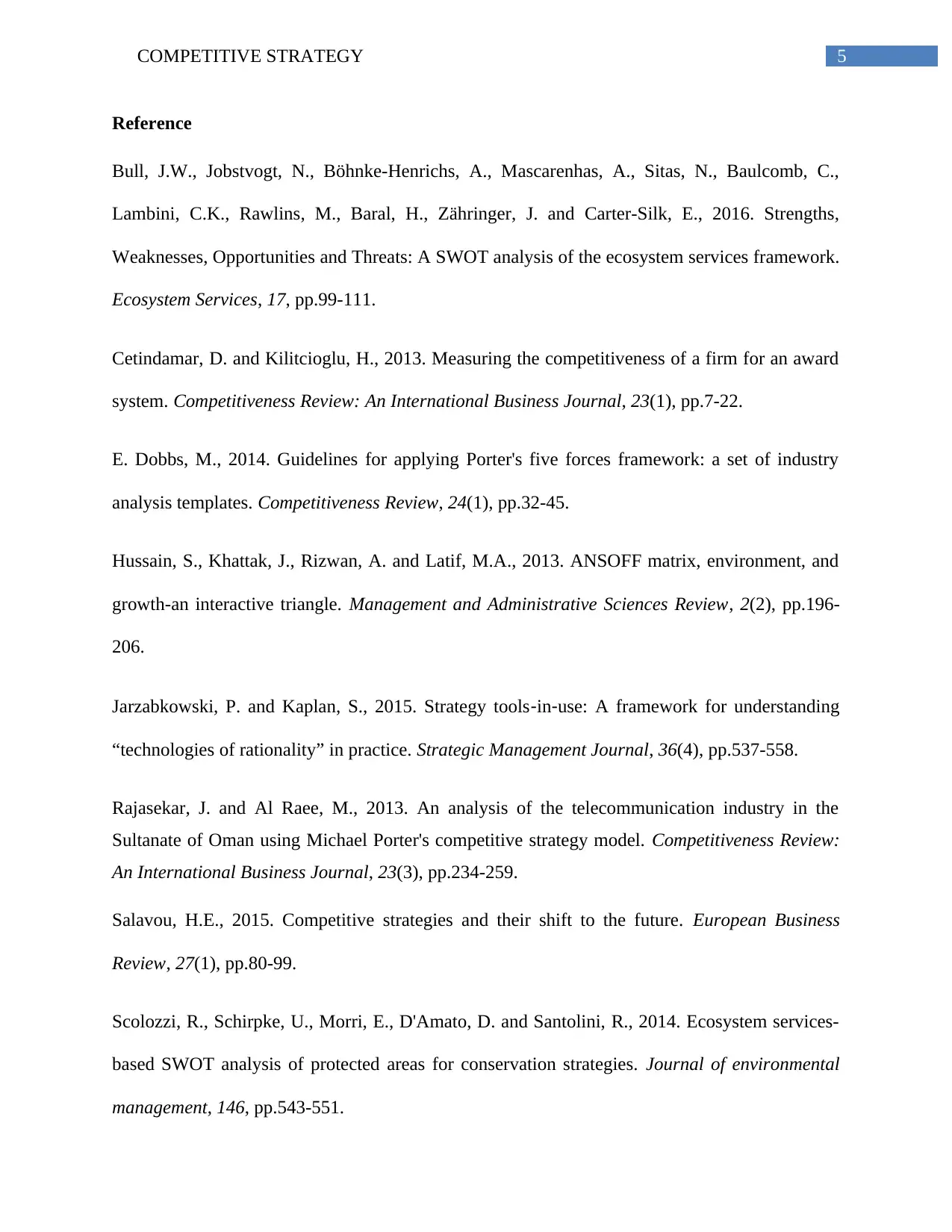
5COMPETITIVE STRATEGY
Reference
Bull, J.W., Jobstvogt, N., Böhnke-Henrichs, A., Mascarenhas, A., Sitas, N., Baulcomb, C.,
Lambini, C.K., Rawlins, M., Baral, H., Zähringer, J. and Carter-Silk, E., 2016. Strengths,
Weaknesses, Opportunities and Threats: A SWOT analysis of the ecosystem services framework.
Ecosystem Services, 17, pp.99-111.
Cetindamar, D. and Kilitcioglu, H., 2013. Measuring the competitiveness of a firm for an award
system. Competitiveness Review: An International Business Journal, 23(1), pp.7-22.
E. Dobbs, M., 2014. Guidelines for applying Porter's five forces framework: a set of industry
analysis templates. Competitiveness Review, 24(1), pp.32-45.
Hussain, S., Khattak, J., Rizwan, A. and Latif, M.A., 2013. ANSOFF matrix, environment, and
growth-an interactive triangle. Management and Administrative Sciences Review, 2(2), pp.196-
206.
Jarzabkowski, P. and Kaplan, S., 2015. Strategy tools‐in‐use: A framework for understanding
“technologies of rationality” in practice. Strategic Management Journal, 36(4), pp.537-558.
Rajasekar, J. and Al Raee, M., 2013. An analysis of the telecommunication industry in the
Sultanate of Oman using Michael Porter's competitive strategy model. Competitiveness Review:
An International Business Journal, 23(3), pp.234-259.
Salavou, H.E., 2015. Competitive strategies and their shift to the future. European Business
Review, 27(1), pp.80-99.
Scolozzi, R., Schirpke, U., Morri, E., D'Amato, D. and Santolini, R., 2014. Ecosystem services-
based SWOT analysis of protected areas for conservation strategies. Journal of environmental
management, 146, pp.543-551.
Reference
Bull, J.W., Jobstvogt, N., Böhnke-Henrichs, A., Mascarenhas, A., Sitas, N., Baulcomb, C.,
Lambini, C.K., Rawlins, M., Baral, H., Zähringer, J. and Carter-Silk, E., 2016. Strengths,
Weaknesses, Opportunities and Threats: A SWOT analysis of the ecosystem services framework.
Ecosystem Services, 17, pp.99-111.
Cetindamar, D. and Kilitcioglu, H., 2013. Measuring the competitiveness of a firm for an award
system. Competitiveness Review: An International Business Journal, 23(1), pp.7-22.
E. Dobbs, M., 2014. Guidelines for applying Porter's five forces framework: a set of industry
analysis templates. Competitiveness Review, 24(1), pp.32-45.
Hussain, S., Khattak, J., Rizwan, A. and Latif, M.A., 2013. ANSOFF matrix, environment, and
growth-an interactive triangle. Management and Administrative Sciences Review, 2(2), pp.196-
206.
Jarzabkowski, P. and Kaplan, S., 2015. Strategy tools‐in‐use: A framework for understanding
“technologies of rationality” in practice. Strategic Management Journal, 36(4), pp.537-558.
Rajasekar, J. and Al Raee, M., 2013. An analysis of the telecommunication industry in the
Sultanate of Oman using Michael Porter's competitive strategy model. Competitiveness Review:
An International Business Journal, 23(3), pp.234-259.
Salavou, H.E., 2015. Competitive strategies and their shift to the future. European Business
Review, 27(1), pp.80-99.
Scolozzi, R., Schirpke, U., Morri, E., D'Amato, D. and Santolini, R., 2014. Ecosystem services-
based SWOT analysis of protected areas for conservation strategies. Journal of environmental
management, 146, pp.543-551.
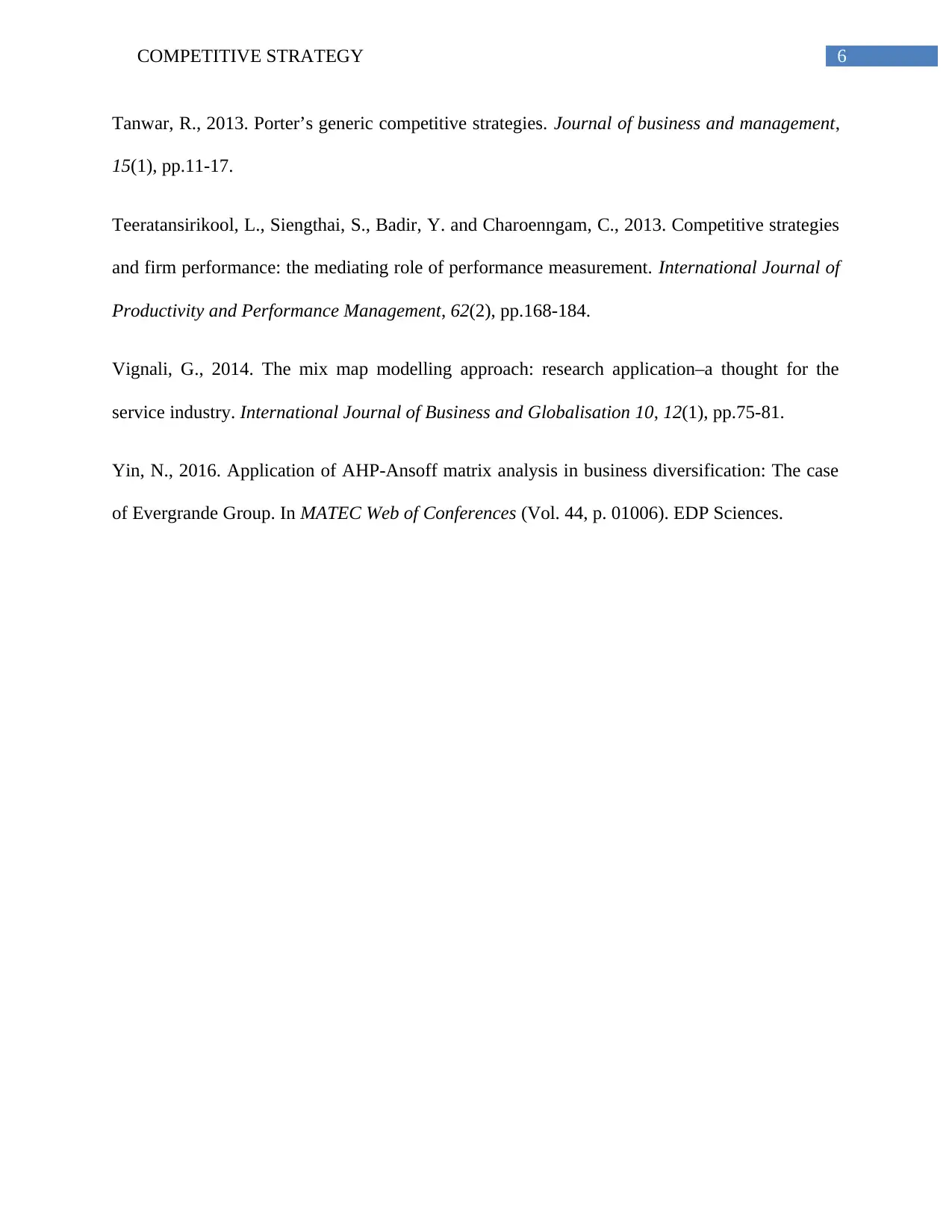
6COMPETITIVE STRATEGY
Tanwar, R., 2013. Porter’s generic competitive strategies. Journal of business and management,
15(1), pp.11-17.
Teeratansirikool, L., Siengthai, S., Badir, Y. and Charoenngam, C., 2013. Competitive strategies
and firm performance: the mediating role of performance measurement. International Journal of
Productivity and Performance Management, 62(2), pp.168-184.
Vignali, G., 2014. The mix map modelling approach: research application–a thought for the
service industry. International Journal of Business and Globalisation 10, 12(1), pp.75-81.
Yin, N., 2016. Application of AHP-Ansoff matrix analysis in business diversification: The case
of Evergrande Group. In MATEC Web of Conferences (Vol. 44, p. 01006). EDP Sciences.
Tanwar, R., 2013. Porter’s generic competitive strategies. Journal of business and management,
15(1), pp.11-17.
Teeratansirikool, L., Siengthai, S., Badir, Y. and Charoenngam, C., 2013. Competitive strategies
and firm performance: the mediating role of performance measurement. International Journal of
Productivity and Performance Management, 62(2), pp.168-184.
Vignali, G., 2014. The mix map modelling approach: research application–a thought for the
service industry. International Journal of Business and Globalisation 10, 12(1), pp.75-81.
Yin, N., 2016. Application of AHP-Ansoff matrix analysis in business diversification: The case
of Evergrande Group. In MATEC Web of Conferences (Vol. 44, p. 01006). EDP Sciences.
1 out of 7
Related Documents
Your All-in-One AI-Powered Toolkit for Academic Success.
+13062052269
info@desklib.com
Available 24*7 on WhatsApp / Email
![[object Object]](/_next/static/media/star-bottom.7253800d.svg)
Unlock your academic potential
© 2024 | Zucol Services PVT LTD | All rights reserved.





